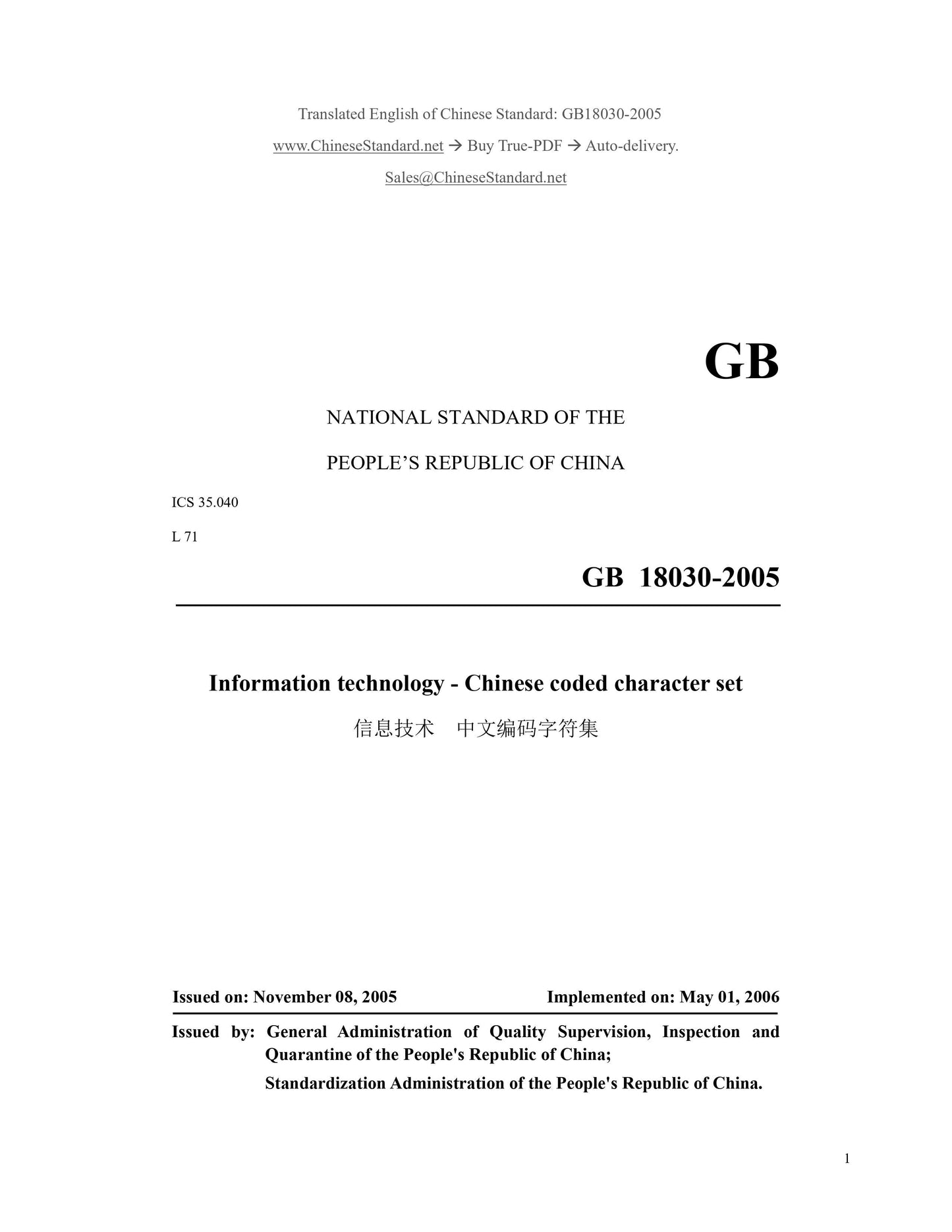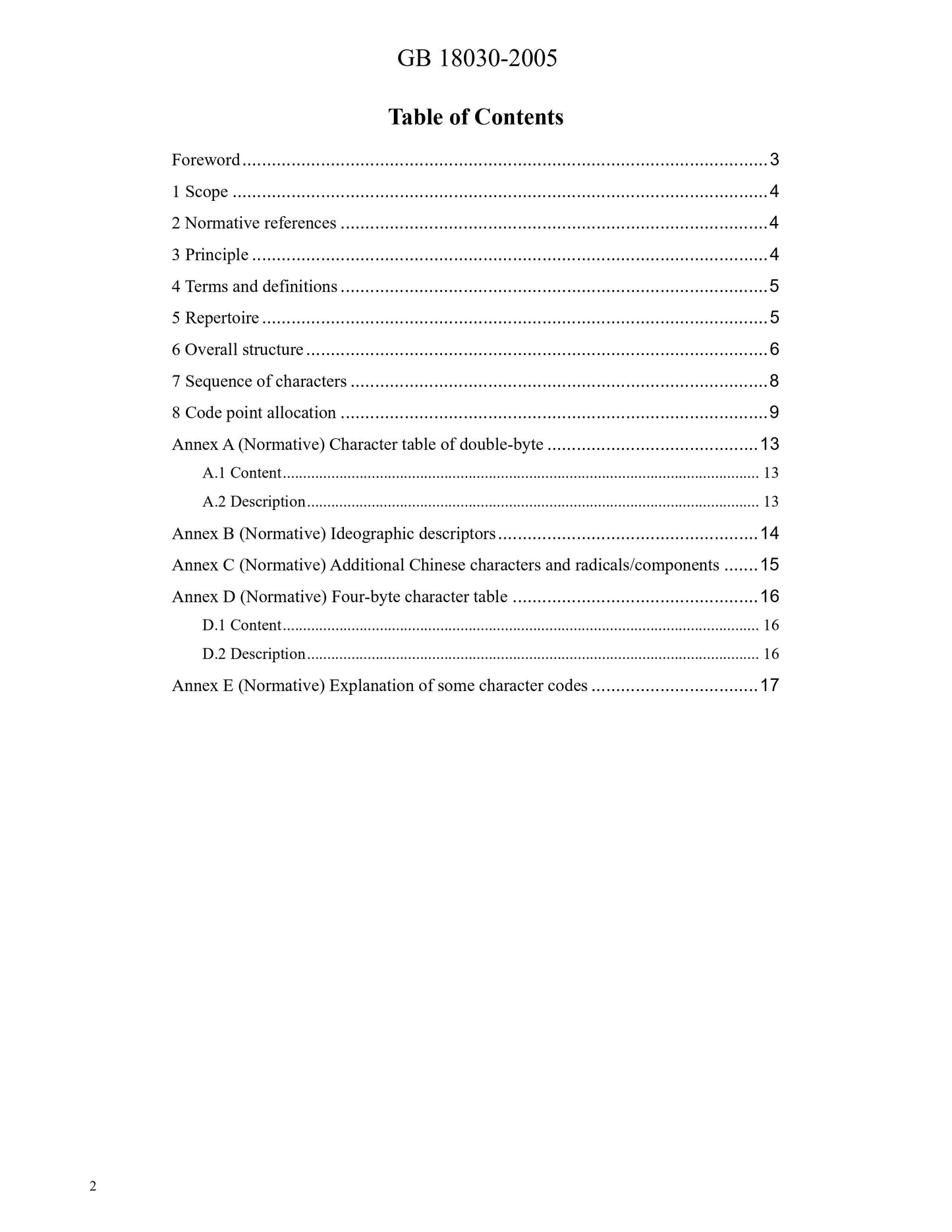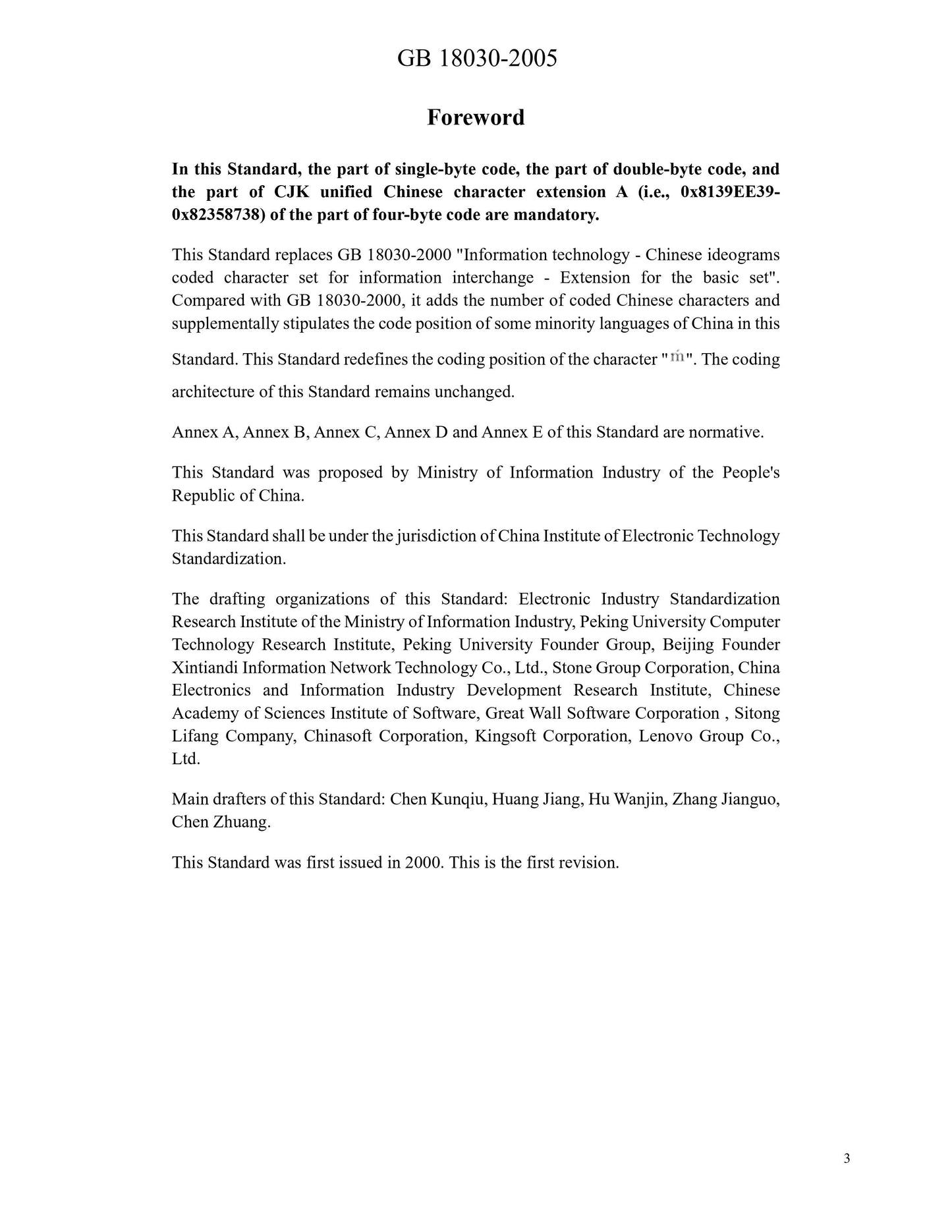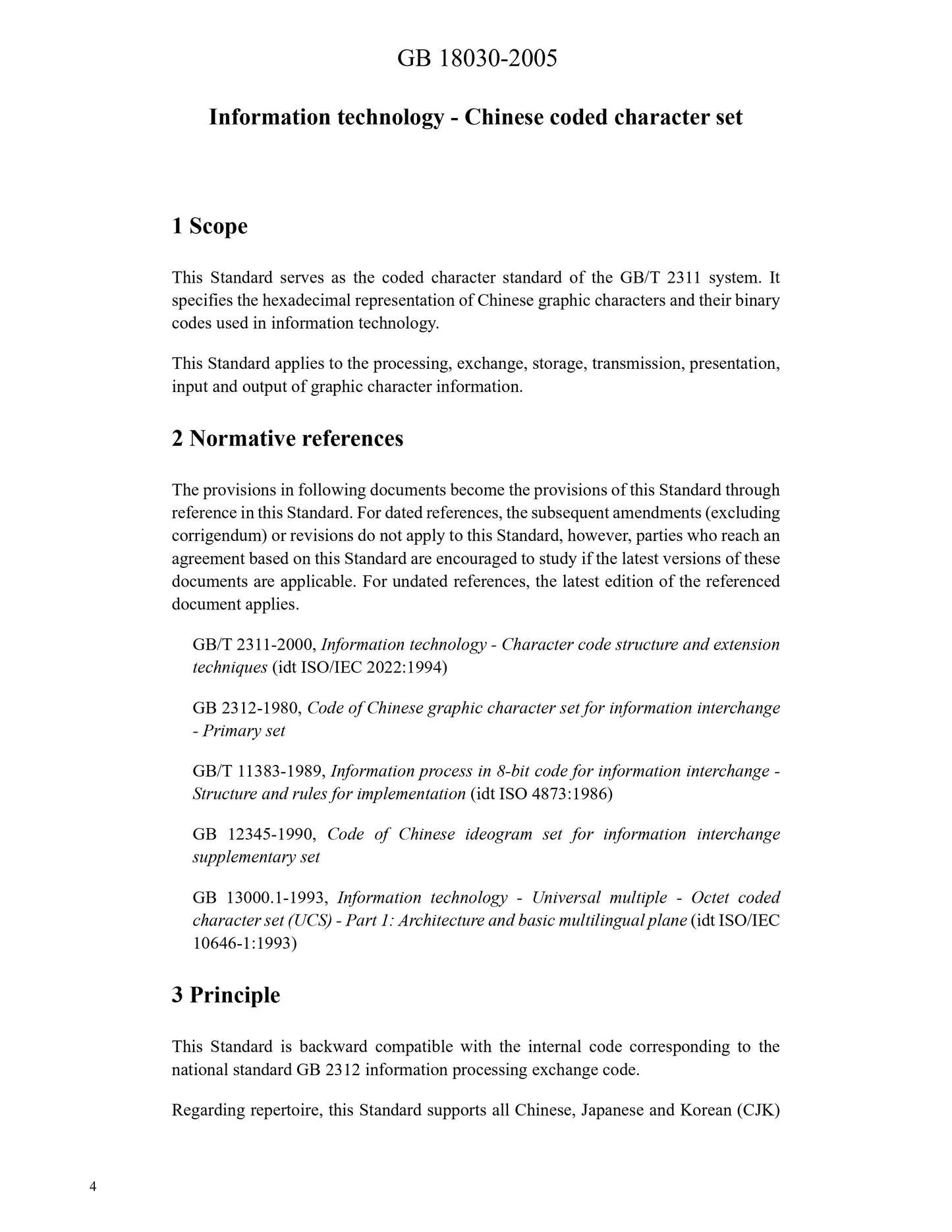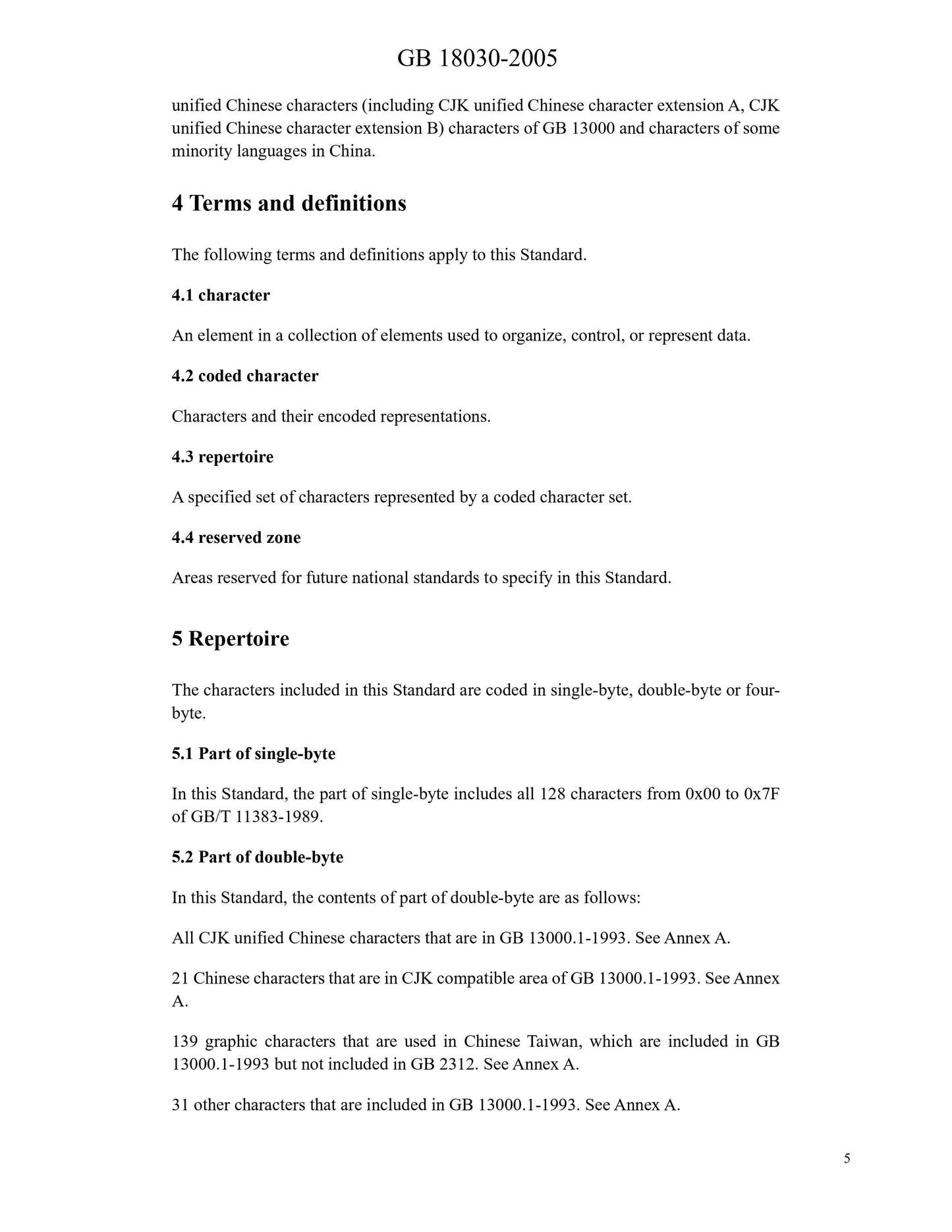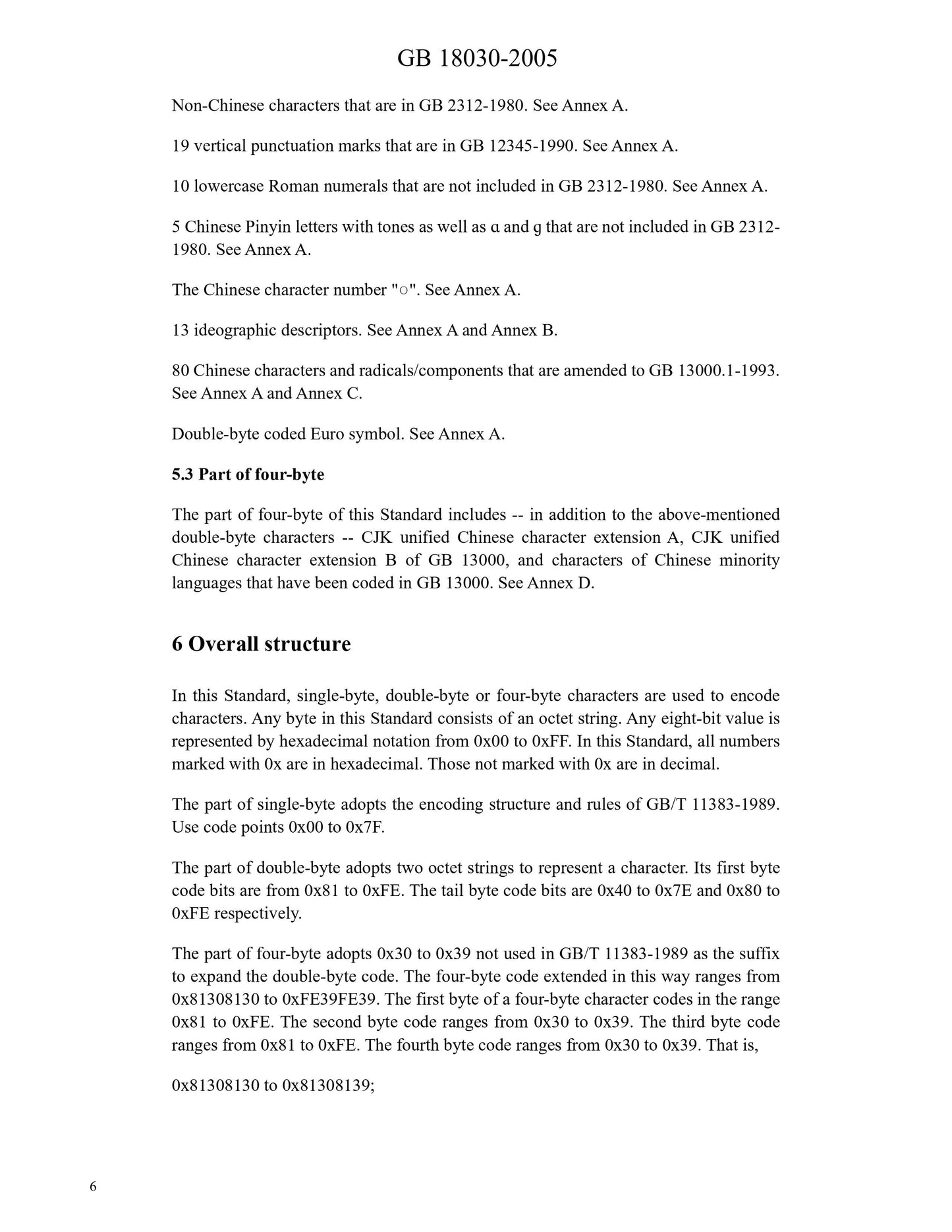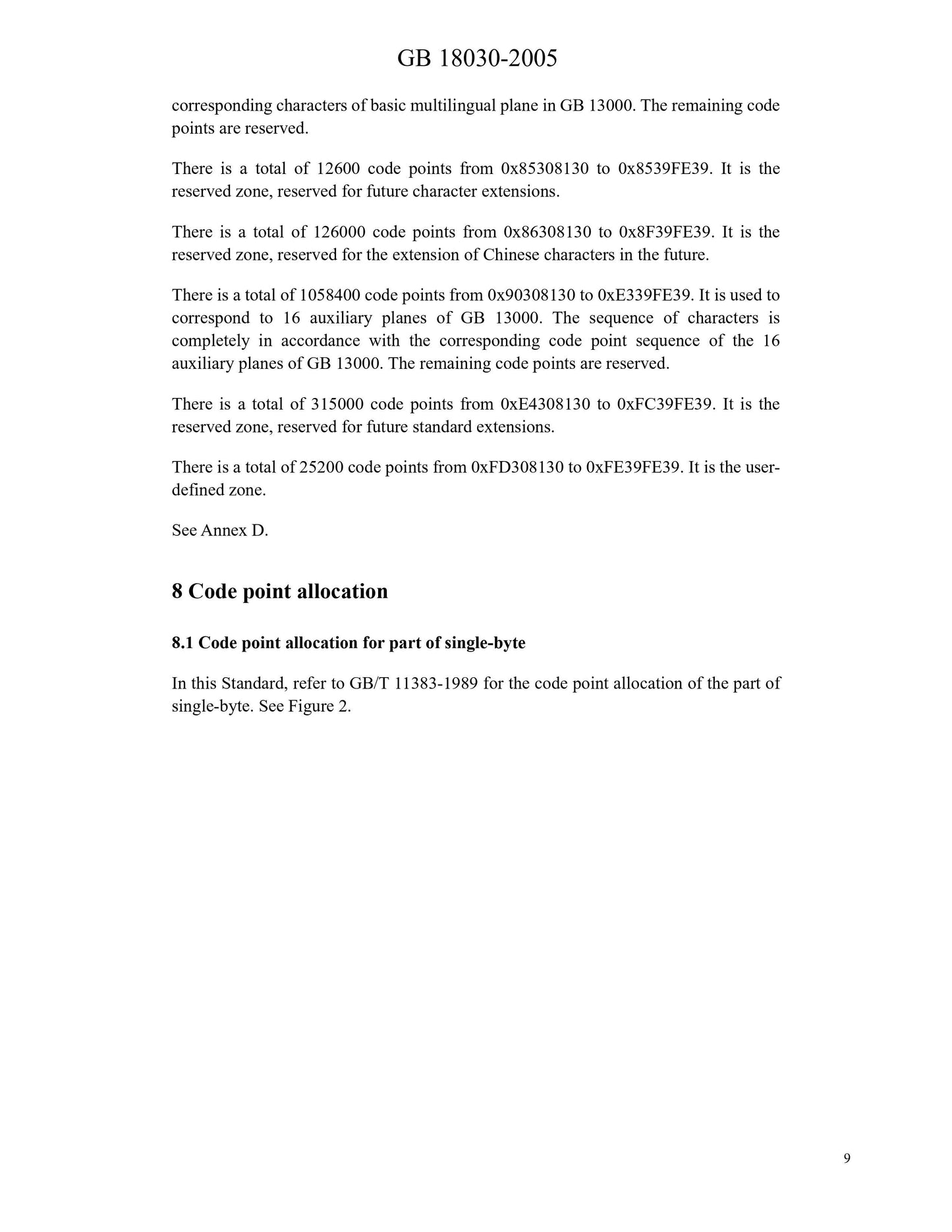1
/
of
7
PayPal, credit cards. Download editable-PDF & invoice in 1 second!
GB 18030-2005 English PDF (GB18030-2005)
GB 18030-2005 English PDF (GB18030-2005)
Regular price
$4,690.00 USD
Regular price
Sale price
$4,690.00 USD
Unit price
/
per
Shipping calculated at checkout.
Couldn't load pickup availability
Delivery: 3 seconds. Download true-PDF + Invoice.Newer version: (Replacing this standard) GB 18030-2022
Get QUOTATION in 1-minute: Click GB 18030-2005
Historical versions: GB 18030-2005
Preview True-PDF (Reload/Scroll if blank)
GB 18030-2005: Information technology -- Chinese coded character set
GB
NATIONAL STANDARD OF THE
PEOPLE’S REPUBLIC OF CHINA
ICS 35.040
L 71
GB 18030-2005
Information technology - Chinese coded character set
ISSUED ON: NOVEMBER 08, 2005
IMPLEMENTED ON: MAY 01, 2006
Issued by: General Administration of Quality Supervision, Inspection and
Quarantine of the People's Republic of China;
Standardization Administration of the People's Republic of China.
Table of Contents
Foreword ... 3
1 Scope ... 4
2 Normative references ... 4
3 Principle ... 4
4 Terms and definitions ... 5
5 Repertoire ... 5
6 Overall structure ... 6
7 Sequence of characters ... 8
8 Code point allocation ... 9
Annex A (Normative) Character table of double-byte ... 13
A.1 Content ... 13
A.2 Description ... 13
Annex B (Normative) Ideographic descriptors ... 14
Annex C (Normative) Additional Chinese characters and radicals/components ... 15
Annex D (Normative) Four-byte character table ... 16
D.1 Content ... 16
D.2 Description ... 16
Annex E (Normative) Explanation of some character codes ... 17
GB 18030-2005
Foreword
In this Standard, the part of single-byte code, the part of double-byte code, and
the part of CJK unified Chinese character extension A (i.e., 0x8139EE39-
0x82358738) of the part of four-byte code are mandatory.
This Standard replaces GB 18030-2000 "Information technology - Chinese ideograms
coded character set for information interchange - Extension for the basic set".
Compared with GB 18030-2000, it adds the number of coded Chinese characters and
supplementally stipulates the code position of some minority languages of China in this
Standard. This Standard redefines the coding position of the character " ". The coding
architecture of this Standard remains unchanged.
Annex A, Annex B, Annex C, Annex D and Annex E of this Standard are normative.
This Standard was proposed by Ministry of Information Industry of the People's
Republic of China.
This Standard shall be under the jurisdiction of China Institute of Electronic Technology
Standardization.
The drafting organizations of this Standard: Electronic Industry Standardization
Research Institute of the Ministry of Information Industry, Peking University Computer
Technology Research Institute, Peking University Founder Group, Beijing Founder
Xintiandi Information Network Technology Co., Ltd., Stone Group Corporation, China
Electronics and Information Industry Development Research Institute, Chinese
Academy of Sciences Institute of Software, Great Wall Software Corporation , Sitong
Lifang Company, Chinasoft Corporation, Kingsoft Corporation, Lenovo Group Co.,
Ltd.
Main drafters of this Standard: Chen Kunqiu, Huang Jiang, Hu Wanjin, Zhang Jianguo,
Chen Zhuang.
This Standard was first issued in 2000. This is the first revision.
GB 18030-2005
Information technology - Chinese coded character set
1 Scope
This Standard serves as the coded character standard of the GB/T 2311 system. It
specifies the hexadecimal representation of Chinese graphic characters and their binary
codes used in information technology.
This Standard applies to the processing, exchange, storage, transmission, presentation,
input and output of graphic character information.
2 Normative references
The provisions in following documents become the provisions of this Standard through
reference in this Standard. For dated references, the subsequent amendments (excluding
corrigendum) or revisions do not apply to this Standard, however, parties who reach an
agreement based on this Standard are encouraged to study if the latest versions of these
documents are applicable. For undated references, the latest edition of the referenced
document applies.
GB/T 2311-2000, Information technology - Character code structure and extension
techniques (idt ISO/IEC 2022:1994)
GB 2312-1980, Code of Chinese graphic character set for information interchange
- Primary set
GB/T 11383-1989, Information process in 8-bit code for information interchange -
Structure and rules for implementation (idt ISO 4873:1986)
GB 12345-1990, Code of Chinese ideogram set for information interchange
supplementary set
GB 13000.1-1993, Information technology - Universal multiple - Octet coded
character set (UCS) - Part 1: Architecture and basic multilingual plane (idt ISO/IEC
10646-1:1993)
3 Principle
This Standard is backward compatible with the internal code corresponding to the
national standard GB 2312 information processing exchange code.
Regarding repertoire, this Standard supports all Chinese, Japanese and Korean (CJK)
GB 18030-2005
unified Chinese characters (including CJK unified Chinese character extension A, CJK
unified Chinese character extension B) characters of GB 13000 and characters of some
minority languages in China.
4 Terms and definitions
The following terms and definitions apply to this Standard.
4.1 character
An element in a collection of elements used to organize, control, or represent data.
4.2 coded character
Characters and their encoded representations.
4.3 repertoire
A specified set of characters represented by a coded character set.
4.4 reserved zone
Areas reserved for future national standards to specify in this Standard.
5 Repertoire
The characters included in this Standard are coded in single-byte, double-byte or four-
byte.
5.1 Part of single-byte
In this Standard, the part of single-byte includes all 128 characters from 0x00 to 0x7F
of GB/T 11383-1989.
5.2 Part of double-byte
In this Standard, the contents of part of double-byte are as follows:
All CJK unified Chinese characters that are in GB 13000.1-1993. See Annex A.
21 Chinese characters that are in CJK compatible area of GB 13000.1-1993. See Annex
A.
139 graphic characters that are used in Chinese Taiwan, which are included in GB
13000.1-1993 but not included in GB 2312. See Annex A.
31 other characters that are included in GB 13000.1-1993. See Annex A.
GB 18030-2005
Non-Chinese characters that are in GB 2312-1980. See Annex A.
19 vertical punctuation marks that are in GB 12345-1990. See Annex A.
10 lowercase Roman numerals that are not included in GB 2312-1980. See Annex A.
5 Chinese Pinyin letters with tones as well as ɑ and ɡ that are not included in GB 2312-
1980. See Annex A.
The Chinese character number "○". See Annex A.
13 ideographic descriptors. See Annex A and Annex B.
80 Chinese characters and radicals/components that are amended to GB 13000.1-1993.
See Annex A and Annex C.
Double-byte coded Euro symbol. See Annex A.
5.3 Part of four-byte
The part of four-byte of this Standard includes -- in addition to the above-mentioned
double-byte characters -- CJK unified Chinese character extension A, CJK unified
Chinese character extension B of GB 13000, and characters of Chinese minority
languages that have been coded in GB 13000. See Annex D.
6 Overall structure
In this Standard, single-byte, double-byte or four-byte characters are used to encode
characters. Any byte in this Standard consists of an octet string. Any eight-bit value is
represented by hexadecimal notation from 0x00 to 0xFF. In this Standard, all numbers
marked with 0x are in hexadecimal. Those not marked with 0x are in decimal.
The part of single-byte adopts the encoding structure and rules of GB/T 11383-1989.
Use code points 0x00 to 0x7F.
The part of double-byte adopts two octet strings to represent a character. Its first byte
code bits a...
Get QUOTATION in 1-minute: Click GB 18030-2005
Historical versions: GB 18030-2005
Preview True-PDF (Reload/Scroll if blank)
GB 18030-2005: Information technology -- Chinese coded character set
GB
NATIONAL STANDARD OF THE
PEOPLE’S REPUBLIC OF CHINA
ICS 35.040
L 71
GB 18030-2005
Information technology - Chinese coded character set
ISSUED ON: NOVEMBER 08, 2005
IMPLEMENTED ON: MAY 01, 2006
Issued by: General Administration of Quality Supervision, Inspection and
Quarantine of the People's Republic of China;
Standardization Administration of the People's Republic of China.
Table of Contents
Foreword ... 3
1 Scope ... 4
2 Normative references ... 4
3 Principle ... 4
4 Terms and definitions ... 5
5 Repertoire ... 5
6 Overall structure ... 6
7 Sequence of characters ... 8
8 Code point allocation ... 9
Annex A (Normative) Character table of double-byte ... 13
A.1 Content ... 13
A.2 Description ... 13
Annex B (Normative) Ideographic descriptors ... 14
Annex C (Normative) Additional Chinese characters and radicals/components ... 15
Annex D (Normative) Four-byte character table ... 16
D.1 Content ... 16
D.2 Description ... 16
Annex E (Normative) Explanation of some character codes ... 17
GB 18030-2005
Foreword
In this Standard, the part of single-byte code, the part of double-byte code, and
the part of CJK unified Chinese character extension A (i.e., 0x8139EE39-
0x82358738) of the part of four-byte code are mandatory.
This Standard replaces GB 18030-2000 "Information technology - Chinese ideograms
coded character set for information interchange - Extension for the basic set".
Compared with GB 18030-2000, it adds the number of coded Chinese characters and
supplementally stipulates the code position of some minority languages of China in this
Standard. This Standard redefines the coding position of the character " ". The coding
architecture of this Standard remains unchanged.
Annex A, Annex B, Annex C, Annex D and Annex E of this Standard are normative.
This Standard was proposed by Ministry of Information Industry of the People's
Republic of China.
This Standard shall be under the jurisdiction of China Institute of Electronic Technology
Standardization.
The drafting organizations of this Standard: Electronic Industry Standardization
Research Institute of the Ministry of Information Industry, Peking University Computer
Technology Research Institute, Peking University Founder Group, Beijing Founder
Xintiandi Information Network Technology Co., Ltd., Stone Group Corporation, China
Electronics and Information Industry Development Research Institute, Chinese
Academy of Sciences Institute of Software, Great Wall Software Corporation , Sitong
Lifang Company, Chinasoft Corporation, Kingsoft Corporation, Lenovo Group Co.,
Ltd.
Main drafters of this Standard: Chen Kunqiu, Huang Jiang, Hu Wanjin, Zhang Jianguo,
Chen Zhuang.
This Standard was first issued in 2000. This is the first revision.
GB 18030-2005
Information technology - Chinese coded character set
1 Scope
This Standard serves as the coded character standard of the GB/T 2311 system. It
specifies the hexadecimal representation of Chinese graphic characters and their binary
codes used in information technology.
This Standard applies to the processing, exchange, storage, transmission, presentation,
input and output of graphic character information.
2 Normative references
The provisions in following documents become the provisions of this Standard through
reference in this Standard. For dated references, the subsequent amendments (excluding
corrigendum) or revisions do not apply to this Standard, however, parties who reach an
agreement based on this Standard are encouraged to study if the latest versions of these
documents are applicable. For undated references, the latest edition of the referenced
document applies.
GB/T 2311-2000, Information technology - Character code structure and extension
techniques (idt ISO/IEC 2022:1994)
GB 2312-1980, Code of Chinese graphic character set for information interchange
- Primary set
GB/T 11383-1989, Information process in 8-bit code for information interchange -
Structure and rules for implementation (idt ISO 4873:1986)
GB 12345-1990, Code of Chinese ideogram set for information interchange
supplementary set
GB 13000.1-1993, Information technology - Universal multiple - Octet coded
character set (UCS) - Part 1: Architecture and basic multilingual plane (idt ISO/IEC
10646-1:1993)
3 Principle
This Standard is backward compatible with the internal code corresponding to the
national standard GB 2312 information processing exchange code.
Regarding repertoire, this Standard supports all Chinese, Japanese and Korean (CJK)
GB 18030-2005
unified Chinese characters (including CJK unified Chinese character extension A, CJK
unified Chinese character extension B) characters of GB 13000 and characters of some
minority languages in China.
4 Terms and definitions
The following terms and definitions apply to this Standard.
4.1 character
An element in a collection of elements used to organize, control, or represent data.
4.2 coded character
Characters and their encoded representations.
4.3 repertoire
A specified set of characters represented by a coded character set.
4.4 reserved zone
Areas reserved for future national standards to specify in this Standard.
5 Repertoire
The characters included in this Standard are coded in single-byte, double-byte or four-
byte.
5.1 Part of single-byte
In this Standard, the part of single-byte includes all 128 characters from 0x00 to 0x7F
of GB/T 11383-1989.
5.2 Part of double-byte
In this Standard, the contents of part of double-byte are as follows:
All CJK unified Chinese characters that are in GB 13000.1-1993. See Annex A.
21 Chinese characters that are in CJK compatible area of GB 13000.1-1993. See Annex
A.
139 graphic characters that are used in Chinese Taiwan, which are included in GB
13000.1-1993 but not included in GB 2312. See Annex A.
31 other characters that are included in GB 13000.1-1993. See Annex A.
GB 18030-2005
Non-Chinese characters that are in GB 2312-1980. See Annex A.
19 vertical punctuation marks that are in GB 12345-1990. See Annex A.
10 lowercase Roman numerals that are not included in GB 2312-1980. See Annex A.
5 Chinese Pinyin letters with tones as well as ɑ and ɡ that are not included in GB 2312-
1980. See Annex A.
The Chinese character number "○". See Annex A.
13 ideographic descriptors. See Annex A and Annex B.
80 Chinese characters and radicals/components that are amended to GB 13000.1-1993.
See Annex A and Annex C.
Double-byte coded Euro symbol. See Annex A.
5.3 Part of four-byte
The part of four-byte of this Standard includes -- in addition to the above-mentioned
double-byte characters -- CJK unified Chinese character extension A, CJK unified
Chinese character extension B of GB 13000, and characters of Chinese minority
languages that have been coded in GB 13000. See Annex D.
6 Overall structure
In this Standard, single-byte, double-byte or four-byte characters are used to encode
characters. Any byte in this Standard consists of an octet string. Any eight-bit value is
represented by hexadecimal notation from 0x00 to 0xFF. In this Standard, all numbers
marked with 0x are in hexadecimal. Those not marked with 0x are in decimal.
The part of single-byte adopts the encoding structure and rules of GB/T 11383-1989.
Use code points 0x00 to 0x7F.
The part of double-byte adopts two octet strings to represent a character. Its first byte
code bits a...
Share
